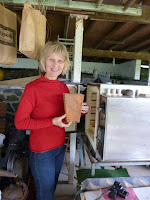Words by The Abbey Museum on the history of the Masterpiece for the Medieval Masterpiece Exhibition 2010...
"In the Middle Ages, a group of artisans engaged in the same occupation - cobblers, stonemasons, carpenters, etc. - would associate theselves for the protection and mutual aid. No one within a town could practise a craft without belonging to the appropriate guild association.
Members of the craft guild were divided into Master, Journeyman, and Apprentice. The master was a very accomplished craftsman who took on apprentices. Usually, these were boys in the teens who were provided food, clothing, shelter, and an education by the master, in return for unpaid work as an apprectice, often for a fixed term of service from about two to nine years.
My entry SECTION 7 - Aquamanile FIRST PRIZE - Master Artisan
After this, an apprentice became a journeyman, who was allowed to work for one or another master and was paid wages for his labour. Once a journeyman could provide proof of his technical and artistic skills, by showing his 'masterpiece', he might rise in the guild and become a master.
 My entry SECTION 7 - Zoomorphic Jug SECOND PRIZE - Journeyman
My entry SECTION 7 - Zoomorphic Jug SECOND PRIZE - Journeyman
From the second half of the thirteenth century onward, we hear, first in isolated instances and then with greater frequency toward the end of the Middle Ages, of a more clearly specified challenge: in order to demonstrate his skill, the candidate must excute a work for official examination, the materpiece.
From the present vantage point, a most striking feature of this Medieval institution of masterpiece-making was its wholly artisan purview. Masterpieces were excuted by goldsmiths and tapestry weavers, to whose handwork we would readily ascribe an 'artistic' quality or intention. But they were also expected of apothecaries, carpenters, rope makers, and other professions".

.JPG)









 Unloading from the kiln...above; Lidwina with her piece and below James...
Unloading from the kiln...above; Lidwina with her piece and below James...



 For the Ceramic readers; notes from the workshop...
For the Ceramic readers; notes from the workshop...
 James and his vase with Lidwina in the background both glazing with Chrome Red Glaze, a popular glaze from my Tafe days.
James and his vase with Lidwina in the background both glazing with Chrome Red Glaze, a popular glaze from my Tafe days. .jpg)
 The kiln loaded and ready for firing. Seeing it's a small load I'm using my single phase, little pocket rocket!
The kiln loaded and ready for firing. Seeing it's a small load I'm using my single phase, little pocket rocket!













 Last night saw the Official Opening of the Medieval Masterpiece Exhibition (30 - 9th July) at
Last night saw the Official Opening of the Medieval Masterpiece Exhibition (30 - 9th July) at